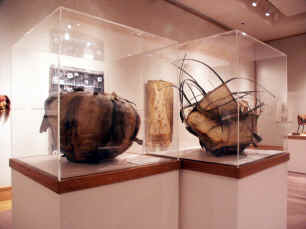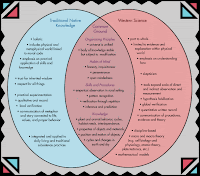Coastal Communities
The communities and cultures of Nanwalkek, Alaska, the Hawaiian Islands, and New Bedford, Massachusetts all share a lifestyle fundamentally dependent on the sea. Particularly in the Aleutian and Hawaiian communities, culture teaches to respect and honor nature and to use everything harvested, right down to fish skin and octopus ink.


Incredible fish skin baskets from Art Scene AK
New Bedford and other East Coast fishing communities were built much more recently in history, and as a result, the cultures that have developed there are “melting pot” cultures – families from cultures as diverse as Portuguese to Norwegian relocated there in the early 1900s in order to find work. Their cultures are still distinct, but over time, some of the customs have been melted together, and many modern day East Coast natives have a rich heritage of a combination of cultures.
Volcanoes are simultaneously violent and destructive and awe-inspiring and beautiful forces that demand respect and dictate lifestyle and culture for communities that live anywhere near them. Like other natural forces, volcanoes wait for no man.
Growing up between Alaska and Hawaii, I have a lot of jumbled memories of times that volcanoes dictated the lives of my family and families in our communities.

Mt. St. Helens eruption, 1980
The 1980 Mt. Saint Helens eruption in Oregon sent clouds of volcanic ash pouring down on our Kenai Peninsula home, burying, my mom swears, our front yard in several inches of dust and blowing up more than one vacuum cleaner.

The continuous eruptions of the Kilauea Volcano on the Big Island in the 1990s covered roads we drove on every day, ate the homes of some of my elementary school buddies’, and added acres of new land to our island on the Kalapana side.

Just last year and the year before, the relatively mild eruptions of Mt. Redoubt, across the Bay from my current home, brought wonderful opportunities for online volcano-monitoring in my middle school science classes.
Stories are important to culture because through them, people pass on an oral tradition rich in history. They allow people to explain natural events that were – before (and even after) scientific explanation – very scary.
Western science offers other explanations for natural events and opportunities for further study. It expands on ideas indigenous people have been observing for hundreds of years.
However, when it ignores the sacred and sustainable aspects of culture in the name of progress and money - such as what is happening at the Mauna Kea observatories on the Big Island and at the possible site of Pebble Mine in Bristol Bay, Alaska - it becomes a negative, destructive force.
Geological Unrest: Earthquakes, Volcanoes, Hot Spots, Tsunamis
Earthquakes and Tsunamis
As the earth’s 29 tectonic plates continually shift and slide on the lithosphere, kinetic energy in the earth’s crust forms seismic waves similar to sound waves.

Use slinkies to demonstrate seismic waves
I have demonstrated these quickly to students of various ages using slinky, which can be compressed in different ways. P, or primary waves, which shake in a forwards-backwards motion, can travel through any type of material, including liquid. They arrive at the focus of an earthquake first because they travel about twice as fast as S waves.
S, or secondary, waves, which move side-to-side, travel more slowly and are thus felt after P waves. They bring much more violent destruction. The most destructive type of wave are surface waves, which travel like water waves along the earth’s surface.

The 1964 Alaskan earthquake was caused by the Pacific Plate subducting underneath the North American plate, where it was temporarily stuck. Valdez was sitting on top of the subducting plate, so when the stress was released, it was affected most greatly by the five minutes of violent shaking that occured on Good Friday, 1964.
Sediments saturated with ground water liquefied because of the shaking, causing 98 million cubic yards to break off and tsunamis waves as high as 30 feet. The ground dropped almost nine feet at the harbor and shifted 30 feet sideways in town.
One oil stove caught fire and the flames quickly spread to other tanks. 32 people died, and the town was evacuated by everyone except people cleaning up the debris and rebuilding the town. Eventually, Valdez was reconstructed on more solid ground three miles away.
Earthquakes often cause tsunamis like the one that began in Valdez in 1964. On July 9th, 1958, around 10:15 in Lituya Bay, which is in Southeast Alaska, an earthquake in the Crillion Inlet caused a landslide that generated a wave of 1,719 feet!
Volcanoes in the Aleutian Trench and Hawaiian Island Chain
The Aluetian Trench, which is about 2,448.95 miles long, is on a convergent boundary, where the Pacific plate is subducting underneath the North American plate. The Aleutian Archipelago is a chain of more than 300 islands born of volcanic activity that extend westward about 1,200 miles off the Alaskan Peninsula.
Many earthquakes occur here because of the kinetic energy that is building up as the earth’s crust moves. Most earthquakes, however, occur at transform boundaries because as two plates slide past each other, they bump over and over again, and the friction causes kinetic energy, which is released by seismic waves.
Click here for screen shots of the Aleutian Trench and the Aleutian Archipelago.
Hawaii Island/Emperor Seamount chain, which starts at the Big Island of Hawaii and continues on until the chain meets the tip of the Aleutian trench, is approximately 3,800 miles long. The Hawaiian Islands are different from the Aleutian Islands because they are being created by hot spot volcanoes, as opposed to the subducting of a plate in the deep-ocean Aleutian trench.
Click here for screen shots of the Hawaii Island/Emperor Seamount chain.
Creation of the Aleutian Islands

The northwest-moving Pacific plate is subducting beneath the North American plate. As the plate descends, the temperature and pressure melts the rock of the crust, creating magma, which erupts eventually out of the more than 40 volcanoes in Alaska.
Creation of the Hawaiian Islands
As the Pacific plate travels northwest at about nine centimeters per year, it moves over a hot spot in the earth. The extreme heat may come from radioactivity at the earth’s core. It heats magma and convection currents cause this to rise and break through lithosphere, slowly erupting out of volcanic vents or side-vents and building islands from as far as 30,000 feet below the ocean’s surface over thousands of years.

As the plate continues to move, eventually away from the hot spot, the volcanoes eventually become dormant.
Like the Aleutian Island chain, the Hawaiian Island chain it is not straight; I think this is because of plate tectonics. The Hawaiian islands were and are currently being created by hot spot volcanoes. As the Pacific plate travels northwest over the hot spot in a curved shape, the islands are created following that path.
The Island of Hawaii and the in-construction island of Loihi (still 3,000 feet underneath the water to the east of the Big Island) are currently the only islands whose volcanoes are not dormant; these volcanoes are still over the hot spot.
Extend
Google Earth is an incredible resource for teaching science. As you and your class “fly" to different areas on the globe, students become more engaged because they can really see the area and topic being discussed. Earthquakes and other geological events that happened in the last hour are directly relevant to their lives – and that gets their attention! This morning, I was able to see that on Kodiak and near Cooper Landing, there were 2.9 magnitude earthquakes.
Evaluate
I think Google Earth is extremely valuable in teaching earth science because seeing things in real time and real space that are directly relevant to students' lives gets them interested and engaged.
The ruler feature allows students to get a concrete idea of the special relationships between places they are studying and the place they are standing. When students are able to use technology to “see things” like this, they want to pay attention to the rest of the lesson because they care about the information.
Then, when teachers use other digital media, like videos and interactives from Teacher’s Domain, You Tube, and Discovery Education (as well as other resources), to explain and demonstrate types of geological events, students already have a link in their schema – they understand that these things are really happening on the globe near them. Some may even seek out other resources.


